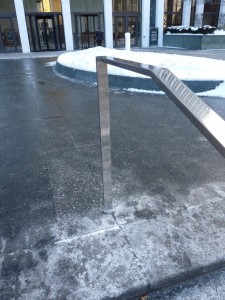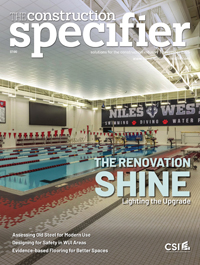Avoiding de-icing salt corrosion
 FAILURES
FAILURES
Catherine Houska, CSI
Salt corrosion is not only a problem near the seashore—in fact, there is a significant, and often unrecognized, risk in ‘inland’ areas where seasonal de-icing salts are regularly used.Salt accumulations have been documented up to 1.9 km (1.2 mi) downwind from busy roadways and as high as the 59th floor of high-rises. Accumulations are highest at the lowest levels of structures. De-icing salt is used globally where snow or ice is a seasonal roadway safety hazard. Sodium chloride (i.e. rock salt) is the dominant de-icing product, but use of calcium chloride and sometimes magnesium chloride has increased significantly over the past decade.
 Moisture must be present for corrosion to occur. All three of these salts (chlorides) are hygroscopic and absorb moisture from the air once certain temperature and humidity levels are achieved and become actively corrosive. Sodium chloride becomes continuously corrosive above 10 C (50 F) and 76 percent relative humidity (RH). Most is washed away with heavy rain in the spring before those conditions are regularly met. Calcium and magnesium chlorides are corrosive at 0 C (32 F) and 45 or 50 percent, respectively. Their increased use is making the environment more corrosive.
Moisture must be present for corrosion to occur. All three of these salts (chlorides) are hygroscopic and absorb moisture from the air once certain temperature and humidity levels are achieved and become actively corrosive. Sodium chloride becomes continuously corrosive above 10 C (50 F) and 76 percent relative humidity (RH). Most is washed away with heavy rain in the spring before those conditions are regularly met. Calcium and magnesium chlorides are corrosive at 0 C (32 F) and 45 or 50 percent, respectively. Their increased use is making the environment more corrosive.
Although stainless steel is the most corrosion-resistant of the common architectural metals, there are many different alloys that significantly vary in terms of performance. De-icing salt will cause at least superficial corrosion staining of Type 304 and less-resistant stainless steels. If a smooth finish is used, Type 316 is the preferred choice for low to moderate salt exposure environments.
Both railings pictured here are Type 316, exposed to de-icing salt and separated from roadways by a sidewalk. The rough finish on the abrasive-blasted surface retains far more salt and is exhibiting superficial corrosion. White salt crystals can be seen on the surface. The smooth surface has somewhat higher salt exposure but has no corrosion. Smoother finishes accumulate less salt and are more easily cleaned naturally by rain. If a rough finish is desired or salt exposure is higher, then a more corrosion-resistant stainless steel, such as 2205, is required.
The opinions expressed in Failures are based on the authors’ experiences and do not necessarily reflect those of the CSI or The Construction Specifier.
Catherine Houska, CSI, is a senior development manager at TMR Consulting. She is a metallurgical engineering consultant specializing in architectural metal specification, restoration, and failure analysis. Houska has authored more than 150 publications, including several features for The Construction Specifier. She can be reached via e-mail at chouska@tmr-inc.com.


